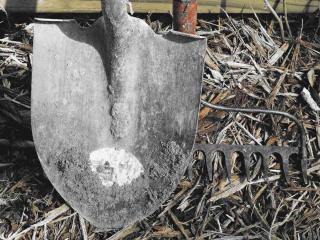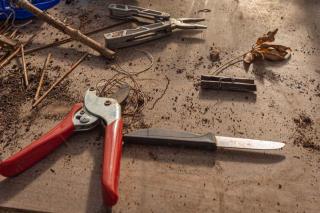

After the last tasks of fall and before putting them away, it is important to thoroughly clean your tools. Maintaining them properly will let them last a lifetime. They’ll stay effective and also won’t spread diseases in the vegetable patch and in flower beds.
If you weren’t able to practice regular maintenance during spring, summer and fall, seize the chance offered by winter dormancy. Give your tools a check-up before setting them to rest, too! They’ll be ready for use after the winter hibernation!

Remove tree sap and organic matter from pruning equipment with rubbing alcohol.
Rub very fine sandpaper on rust spots, the finest possible so that you won’t scratch the metal any further. The smoother the surface, the less moisture can collect and start rusting again.
For tools you don’t use very often, spray a water repellent like oil or WD-40. Note that this wears off even if you don’t use the tools, so set up a schedule to repeat the application every 3 months (every month in moist tropical places).

Clean empty pots, garden boxes and stakes with chlorinated water. Rinse and dry.
Inspect your equipment to locate and repair whatever might be broken. Tighten screws and replace or fix defective latches and handles (wood handles that start splitting can become dangerous).
Run a metal file along the blade of sharp tools.
Use a whetting stone to sharpen cutting tools, taking great care to follow the angle of the bevel.
Gas-powered tools must be flushed every year.
Also check that you’ve purged the watering hose, it might burst from freezing.
Rub the equipment with flax seed oil (linseed oil). Use a brush or rag.
This will extend the lifespan of wood handles when not varnished, and will keep water and rust away from metallic parts.
Hang the rag or brush covered in linseed oil in a very well-ventilated place. As the oil cures or dries, it forms a water repelling barrier. This process generates heat, to the point that it can actually catch fire. To prevent the heat from building up, it’s important to let air circulate well around the oil-imbibed item.
Put your tools away in a dry spot, metallic parts facing up. Make sure children can’t access sharper tools or fall atop them.
Martine de Saint Jan, minor edits by Gaspard Lorthiois